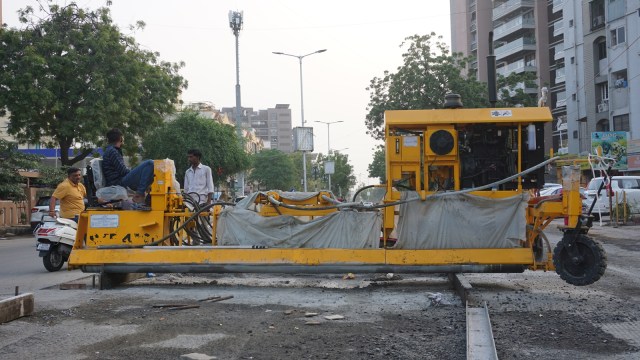Longevity, better at tackling waterlogging: Over 40 white-topped roads set to soon come up in Ahmedabad
A team of engineers from the AMC went to Bangalore in 2022 to study and evaluate the white-topped roads in the city. After coming back, the civic body got down to the pursuit of developing such roads in Ahmedabad.
 The roads in the first phase are nearly complete. (Express File Photo)
The roads in the first phase are nearly complete. (Express File Photo)In a step forward to make the commute easier for city-dwellers, over 40 white-topped roads are set to come up in Ahmedabad in the coming months. In the first phase of an ongoing project, the Ahmedabad Municipal Corporation (AMC) has nearly completed seven stretches at a cost of nearly Rs 19.42 crore.
As compared to asphalt roads, “white-topped” roads are better in terms of tackling waterlogging, as per officials. The roads have a layer of Portland cement concrete laid on asphalt. With white-topping making the stretch more reflective, the process also ensures lowering the temperature in the vicinity slightly. The longevity also increases with the use of concrete.
A total amount of Rs 400 crore has been sanctioned for the three-phased project, people aware of the details shared with The Indian Express.
The first phase, which is now almost finished, covers seven white-topped roads. In the second phase, a total amount of Rs 82.5 crore has been allotted for 21 roads spread across 27 km on the Eastern Side. Funds worth Rs 88 crore have been allocated for the Western Side for 20 roads, spread over 16 km.
The tender of the third phase is now online and is divided into three sub-divisions of Rs 60 crore each, which will commence after the completion of the second phase. “The traditional bitumen-asphalt roads witness bleeding (cracking) during harsh summers in Ahmedabad when the temperature reaches up to 47 degrees. Bangalore was the first in the country to address the bitumen degradation of its tropical climate’s humid temperature. We started it in Ahmedabad from the Gurukul Road. The work was finished before Diwali,” said AMC city engineer Harpalsinh Zala.
“The objective was also to address waterlogging. Topologically, there are places like Parimal Garden in Ahmedabad, which are low-lying… and we call these areas depression. In these places, the traditional roads have deteriorated. Our priority right now is to take the roads with depressions and rely on white-topping,” he added. In view of waterlogging and subsequent problems with the bitumen-laid roads, the AMC took to building concrete roads. One of the first roads in Ahmedabad to be built of concrete was the Sindhu Bhavan Road (SBR), now among the city’s most upscale streets, 12 years ago. This was followed by the road connecting Ramdevnagar, which was built in the year 2013-14, as per officials. It was a Pavement Quality Concrete (PQC) road — 300 m thick. But it took over 1.5 years to complete construction.
Zala stated that places like Shivranjini faced waterlogging due to the higher level of RCC (Roller-compacted concrete) roads on which milling was not done. “Milling is a process which is used to mill down the roads before applying the concrete mix to it. In RCC roads earlier, it wasn’t done but we’re doing it on white-topped roads. However, as Shivranjini was a waterlogging-prone area, RCC was used to fix the issue quickly,” he explained.
A team of engineers from the AMC went to Bangalore in 2022 to study and evaluate the white-topped roads in the city. After coming back, the civic body got down to the pursuit of developing such roads in Ahmedabad.
The contract for building these white-topped roads has been awarded to construction firm B.R Goyal Private Limited for the first phase and Maruti Construction for the second phase. According to Zala, white-topping costs 1.8 times more than traditional asphalt roads and the turnaround time also increases. Traditional roads only take 4-5 days to finish, but white-topped roads take about 6-7 months.
According to AMC officials, the white colour comes from the cement and fly ash, which is mixed with the lean concrete mix. The colour provides multiple benefits compared to traditional roads.
One is the lowering of the temperature as the roads remaincooler compared to black bitumen roads which retain the heat due to the black colour. Moreover, there is increased visibility on these roads as the reflectivity increases, making it easier to navigate in night as well, according to AMC officials.
Compared to traditional roads, white-topped roads are resistant to heat and water. Zala added that white-topped roads provide three times more durability compared to traditional roads.
According to him, the Gurukul white-topped road has faced no damage even after the monsoon this year. However, there are downsides too. “The maintenance of white-topped roads is tougher than traditional roads because if there is a breakage, it is hard to make it homogeneous again… it is hard to match with concrete deployment, with the bitumen roads it is easier to do so,” Zala stated. He further added, “With traditional roads, cave-ins can happen when there is a discrepancy in a water pipe in the ground. However, because of the hard surface of the white-topped roads, we can’t use it widely as well and we will have to check the feasibility then proceed with the project based on needs,” he added.
AMC officials also highlighted that heavy vehicles can’t enter the city till 10 pm, which restricts their working hours to 6-7 hours, effectively increasing the time needed to develop the roads. “Based on the good feedback from the people, we have 80-90 roads for the white-topping in the pipeline,” Zala added.







